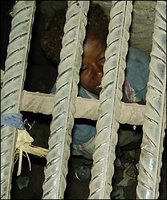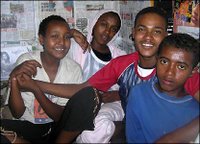The following is a dipection of street children in Addis Ababa Ethiopia, retrived from the BBC's section: In Pictures.
In hiding

Blink and you will miss the underground children in Ethiopia's capital city. They live in tunnels, sewers and drainage holes, hidden beneath Addis Ababa's teeming streets. They move from one makeshift shelter to the next, chased away by police or the rivers of water and refuse that flow when the rains come. Growing up amidst the traffic, they learn to hustle at a young age seeking change or selling small items to drivers at traffic lights.
Hidden

Across from the main post office, there is a sewage drain. It draws little attention. Thousands of people walk across its steel bars every day without giving it a second thought. This is good for Mohammed and his friends. They do not want their home to be discovered. The space is not more than half a metre high, and though it is five or six metres long, only one small portion is covered and unexposed. When it rains, the boys huddle together among the rubbish and waste.
 Crowds
CrowdsEncountering the street kids who live underground is not easy, but once we talked to a few, dozens appeared. As we walked in the shadow of the city’s main buildings, the children emerged from dark side streets and from nowhere at all. Soon we were surrounded by boys.
Hustle

For the children who have found shelter, however destitute and impermanent, the difficulties truly begin when they come up from underground and face the realities of their daily life. They must hustle for food scraps, avoid police, and beware exploitation and abuse. Many children perform odd jobs for restaurants and cafés to get bread and leftovers. Sometimes shelters will give out food, and there are soup kitchens that serve cheap meals.
Hana

There are fewer girls but they are there. Hana, a 15 year-old, comes from Ziway, a town south of Addis. She left home and came to Addis after an incident in which she accidentally lost her family's cattle and feared her father’s rage. She hopes to return one day. "Here you don't have much to worry about," she said.
"If you get something to eat, that is good. When you don't have any, you pass the time either sleeping or chatting with friends."
 Sex
SexWhen they do have money, from begging or doing odd jobs, Hana and her friends often go to the cinema. One of the girls described her attitude to sex. She said that to be safe from both pregnancy and HIV/Aids she always uses a condom. She claimed she did not face serious dangers in this regard, and said no-one had ever forced her to have sex.
Henok

Henok Tesfaye came to the streets when he was 11 years old after losing his parents in a car accident. Ten years on, he is used to life on the streets. He lives beneath a main road in an unused hole dug for telephone cables. The roof is made of concrete blocks placed side by side across a small opening. To keep rain out, Henok and his roommate spread plastic sheets underneath old windscreens. A small hole is both the door and the window to their tiny home.
Numbers

Among the reasons for the high numbers of street children in Addis Ababa are extreme poverty, hunger, violent conflict and drought in rural areas. Often, the children come without families, orphaned by disease, escaping abusive and neglectful parents, captivated by tales of wealth and opportunity in the big city. An exact number is too difficult to pin down accurately, but various estimates put the total number of street kids in Ethiopia between 60,000 and 150,000.
 Dawit
DawitAs we were talking to Dawit, 12, he eyed a rubber wristband and we gave it him, but the next day it had gone. “It was stolen last night,” he said, crestfallen. “When I was sleeping, someone grabbed my neck and started choking me. They said: ‘Give it to me or I’ll take your life.’ So I gave it them.” He shrugged his shoulders and walked off with a friend down the busy street - unnoticed.
Text and pictures: Will Connor and Mesay Berhanu


2 comments:
only 1/2 of 1% of the orphaned children of the world will be adopted. 99.5% are left behind.
99.5% of the money spent on orphans is related to adoption.
Who takes care of those left behind.
that was mean of what that man said it was just a rubbr neck chain . the kid needs that thing more than he dose.i bet that could have let him keep it.that man could have gone to a dollar store and get another.besides i bet kid was only about 6 or 7
Post a Comment